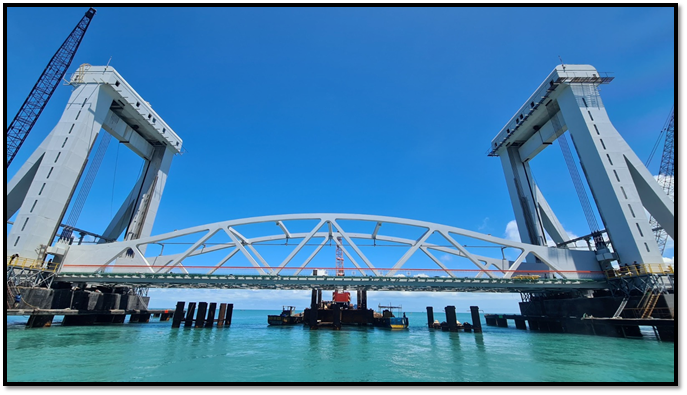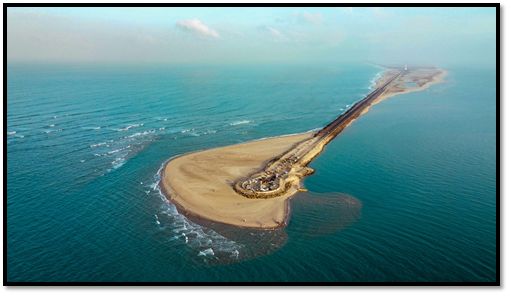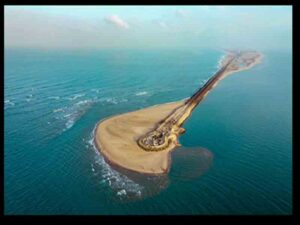New Delhi:(PIB) Imagine sitting in the all-new Rameswaram-Tambaram train service by the window. The salty breeze brushes your face, and all you see is the endless stretch of the sea. Just as the waves begin to lull you into a trance, a stunning steel structure appears, the kind one watches in the movies. It’s the new Pamban Bridge, and it is unlike anything India has ever built before.
The Pamban Strait, which separates the Indian mainland from Rameswaram Island in Tamil Nadu, is now home to an impressive engineering marvel, as India’s first vertical-lift railway sea bridge. Replacing the iconic but aging 110-year-old Pamban bridge, this new structure is more than just metal and bolts, but a symbol of how history and progress can flow together.
What is a Vertical-Lift Railway Sea Bridge?
Imagine a bridge that trains use to go across the sea. Sometimes, big boats need to pass through the same area where the bridge is. A vertical-lift railway sea bridge is a special kind of bridge that can lift up in the middle, just like an elevator going up, so the boats can safely go underneath it.
Once the boat passes, the bridge comes back down so the train can continue its journey. It’s a moving bridge that helps both trains and boats go their way without getting in each other’s path.

From Legacy to Modernity
The original Pamban Bridge was a feat of its time. Inaugurated in 1914, it stood as a proud lifeline connecting pilgrims and traders to the sacred island of Rameswaram. But over the years, time and tides wore it down. Harsh marine conditions, heavy winds, and salt-laden air pushed it to its limits.
That’s when the idea of a new, stronger, and smarter bridge took root.
About 27 meters north of the old bridge now stands its younger, mightier counterpart, stretching 2.07 kilometers across the sea. What makes this bridge truly special is its 72.5-meter-long vertical lift span, a first for Indian Railways. This means when a ship wants to pass, the central section of the bridge can rise up by 17 meters, letting vessels glide through with ease. It’s like watching a piece of the bridge float into the sky.
However, building it wasn’t easy.
Engineers had to deal with choppy waters, tricky winds, and a seabed that tested every calculation. Materials were shipped, welded, and lifted with extreme care.
The new bridge isn’t just smart, but is also built to last. Its foundation is laid deep with over 330 massive piles, frame made with stainless steel reinforcements, and it’s painted with special marine-resistant coatings to survive the salty air. The bridge is also built with the future in mind. While it currently supports one railway track, the foundation is strong enough for two, ready for whatever tomorrow brings.
More Than Metal

But this bridge isn’t just about engineering. The bridge carries a deep cultural significance. According to the Ramayana, the construction of Ram Setu was initiated from Dhanushkodi near Rameswaram. For pilgrims, it offers faster and safer travel to Rameswaram. For locals, it promises better connectivity and economic opportunity. And for the rest of India, it’s a proud reminder of what we can achieve.
Behind the grandeur of the new Pamban Bridge, lies smart technology working silently. A three-cup anemometer constantly monitors wind speed. If it crosses 58 kmph, it triggers an automatic red signal, halting trains to ensure safety. Meanwhile, in the control room at sea, an Atmospheric Water Generator converts air humidity into clean drinking water for on-site staff. Together, these innovations quietly safeguard lives and support the people who keep the bridge running.
So the next time you take that train, let the sea breeze carry you into a moment of reflection. As you cross the new Pamban Bridge, you’re not just moving over water, you’re passing through time, legacy, and innovation. Beneath the waves lies a century of stories, and above them, a promise of India’s future. This bridge is more than an engineering marvel- it connects people, culture and dreams. In its silent strength and graceful rise, it reminds us that progress isn’t just about building new, but also about honoring the old and carrying it forward with pride.





